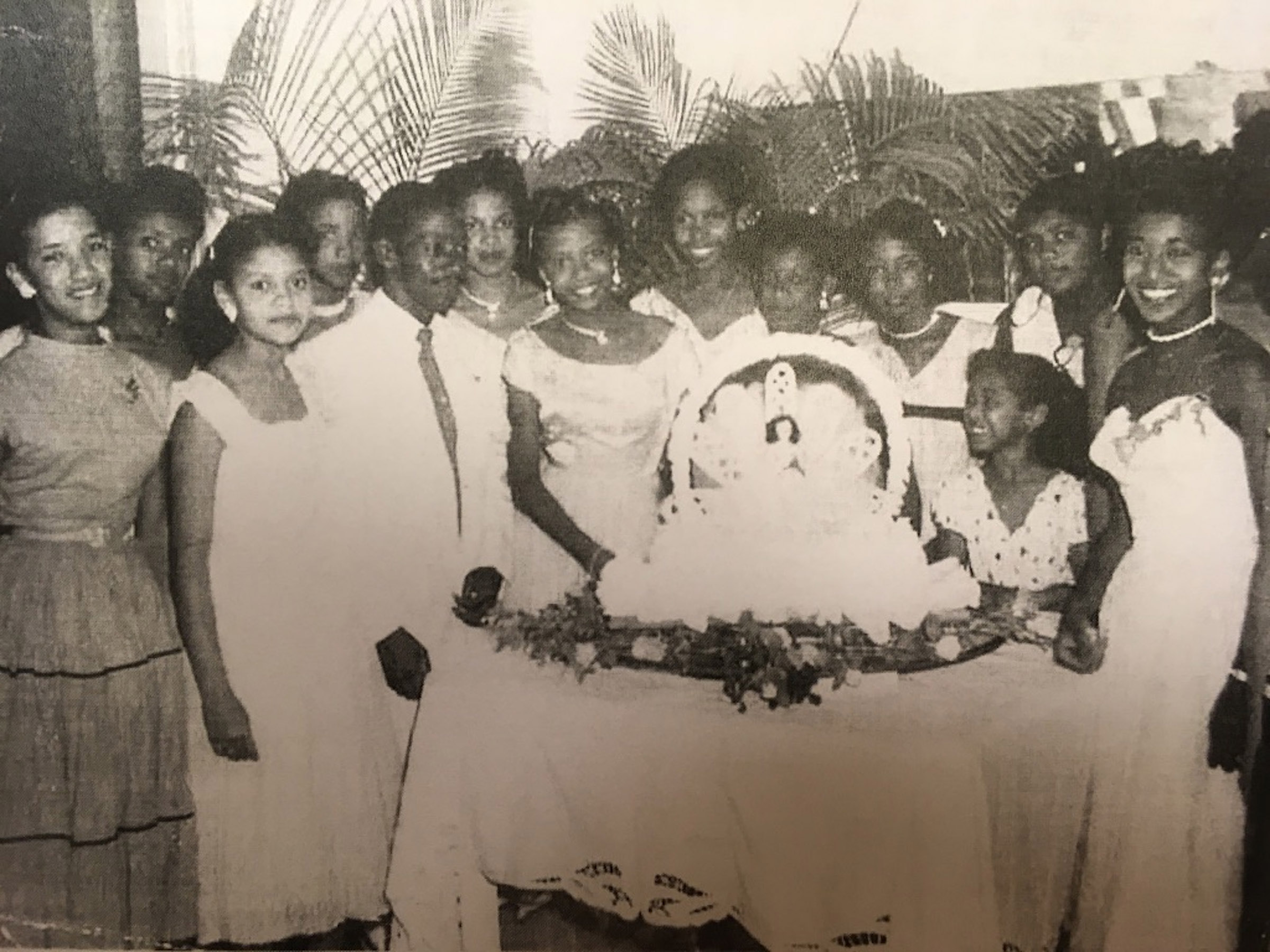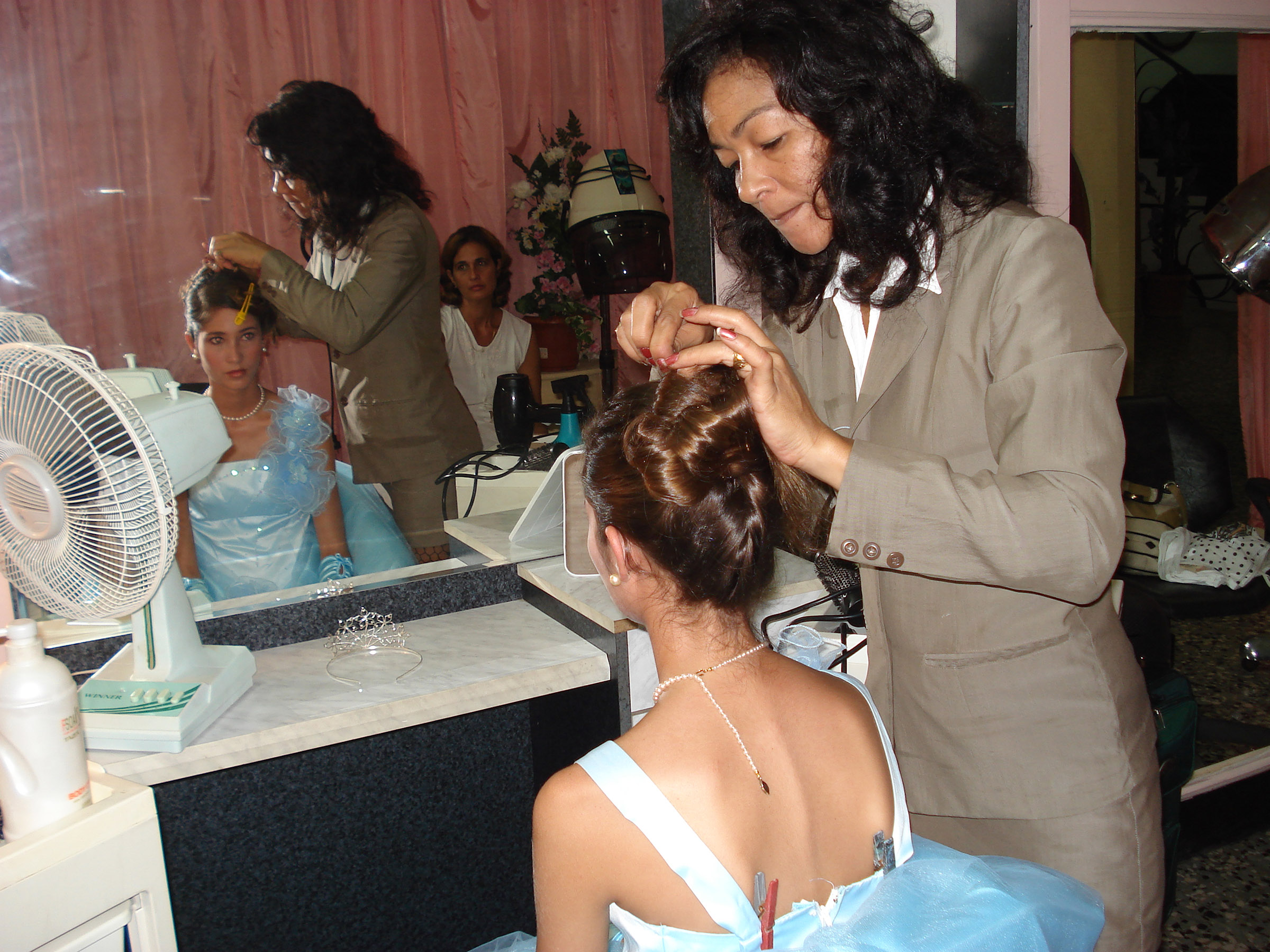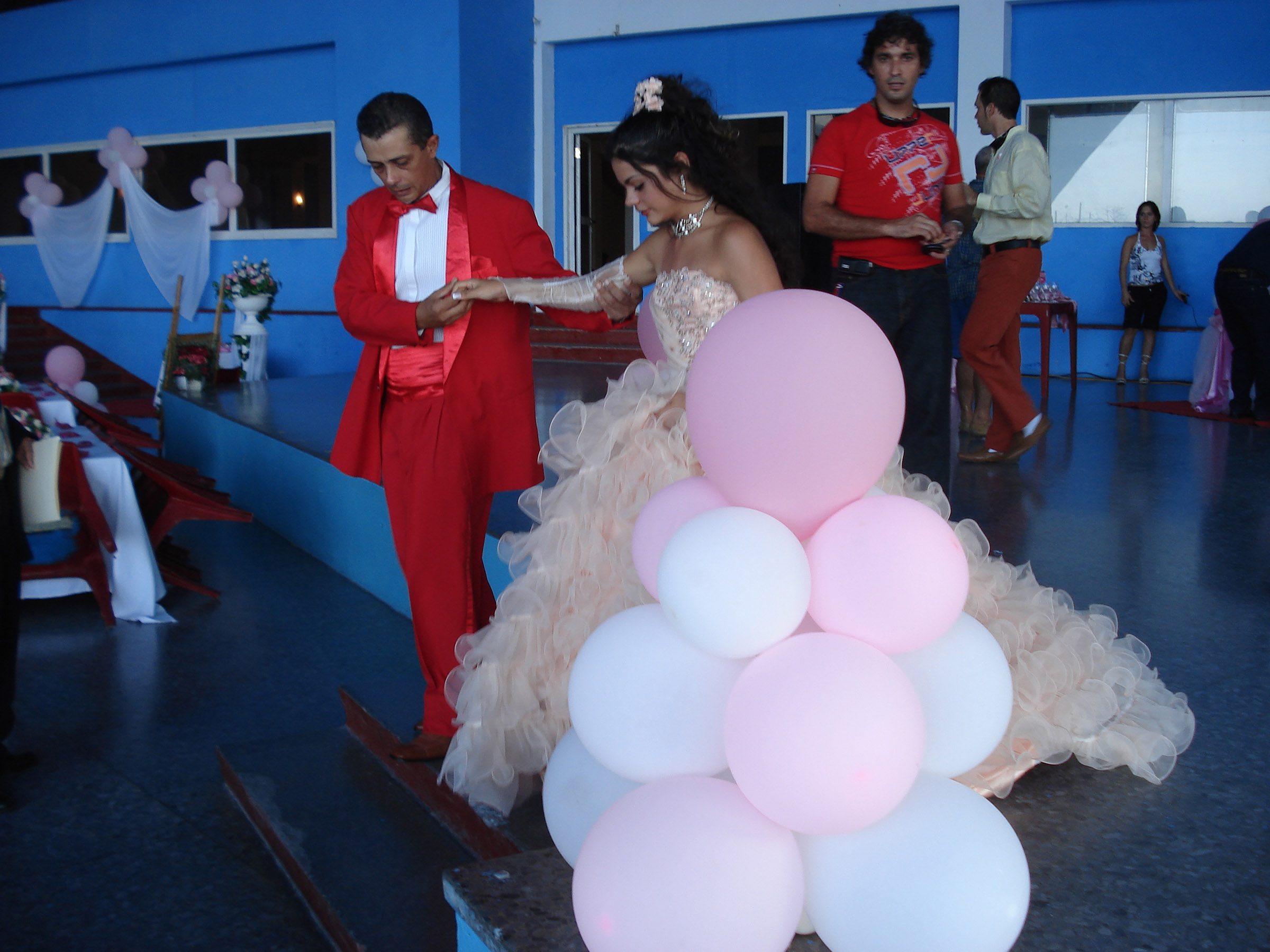Part IV: The Caribbean
Heidi Härkönen
In this chapter, the author explores the phenomenon of flamboyant girls’ fifteenth birthday parties (quinceañeras) as a gender–specific ritual. The author discusses the ways that this life–cycle ritual celebrates the girl’s entry into sexual adulthood, portrays her as an object of heterosexual desire, while simultaneously granting the girls ritual and exotic agency. The author concludes that contemporary quinceañera rituals also reflect the island’s recent political and economic turn toward a more capitalist society and displays the growing racialized and gendered inequalities on the island.
- Describe how rituals can reproduce gender as a socially significant category of differentiation.
- Evaluate how global and state-level historical processes and politics shape local gendered ritual practices.
- Articulate how questions of gendered power and agency are embedded in ritual practices.
When Habanera (Havana resident) girls turn fifteen, their birthday is usually celebrated with a lavish fiesta de los quince años that in its most elaborate form includes a dance party with hundreds of guests and food, drink, and entertainment. The festivities typically include the girl dressing up in puffy dresses imitating eighteenth-century European court fashions and dancing a waltz with a male relative in front of her kin, friends, and neighbors. Boys’ fifteenth birthdays are not celebrated in a similarly grandiose way, making the quince a highly gender specific ritual.

A central part of the ritual consists of the photos taken by a professional photographer where the girl poses in diverse outfits ranging from the latest fashion gear to mermaid costumes. Although the photos often portray the quinceañera as a sensual seductress, the rituals’ meanings are more complex than just presenting the girl as a passive sexual object. In Havana, the quince forms a markedly women’s ritual, highlighting simultaneously the girl’s entry into young adulthood in her kin group and in the process, gaining gendered “erotic agency,” which Holly Wardlow (2006, 232) defines as “the power and delight of being desired.”
Although quinceañeras are celebrated across the Americas, I first encountered the ritual when I was in Havana conducting ethnographic research for my master’s thesis in 2003–2004 (Härkönen 2005). My initial focus was to explore the Catholic confirmation ritual, but I had trouble locating Catholic Cubans who would have undergone confirmation. Although Cuba is historically a Catholic country, its many years as a socialist, officially atheist, society have greatly diminished the role of the Catholic Church on the island. However, Habanera women enthusiastically showed me girls’ quince photos. And as I began to realize how important the ritual was, I shifted my focus to the quince. The quince was a topic that I as a young woman at the time of my initial, relatively brief fieldwork (three months), could easily access. This change of subject exemplifies the unpredictable, frequently improvised character of ethnographic research (Cerwonka and Malkki 2007): instead of strict, preconceived plans, we often need to accommodate our research to locally significant topics. It also shows how our personas—formed by such intersectional (Crenshaw 1989) differences as gender, race, age, and class—shape our research experiences and the information we are able to access (Härkönen 2016b). Our academic selves thus influence the knowledge that we produce, highlighting the importance of reflexivity (Gould and Uusihakala 2016) throughout the research process.
Since my first fieldwork period, I have been back to Havana several times—in 2006, 2007, and 2008—to conduct research on gender, kinship, life cycle, and the state (Härkönen 2014, 2016) and in 2017 and 2019 on well-being and social change. Still, I have always kept an eye on the quince. I have continually worked with the same community of low-income, racially mixed people. However, over the years, I have seen multiple quince photos and videos, spoken with many Habanera girls and women, and participated in quince parties, photoshoots, and dance rehearsals, widening my perspective on the ritual beyond my immediate interlocutors.
I approach the quince as a coming-of-age ritual that is best understood in the context of my interlocutors’ views of kinship and the life course. I define the quince as a coming-of-age ritual because it marks a girl’s transition from childhood into young adulthood. Quince forms part of the larger group of life-cycle rituals that mark important social transitions such as birth, death, and marriage. These rituals have long been of interest to anthropologists (e.g., Richards [1956] 1982; Turner 1969). In a classical study, Arnold van Gennep ([1909] 1960) argues that in these kinds of moments of transition, social categorizations such as gender often become especially visible. Coming-of-age rituals are in many ways similar to initiation rituals, which also typically take place during youth. In initiation rituals, a person is initiated into a new group membership or status (La Fontaine 1985). In initiation rituals, the ritual itself performs the transformation (see La Fontaine 1985); weddings turn lovers into married couples. However, the coming-of-age ritual only marks a change that will occur but may be a more gradual process, such as becoming an adult.
As the quince marks a specific moment in a girl’s life cycle, to understand the ritual in its context, it is important to explore the quince in its full temporal and social framework (Barraud et al. 1994). I connect the centrality of Habanera girls’ quince ritual to women’s important position as mothers in my interlocutors’ kin relations (Härkönen 2016a). Wider Afro-Caribbean ideas of kinship that highlight women’s role as mothers regardless of legal marriage or the (il)legitimacy of children, and the importance of “blood” relations over marital relations, have for long been central in Havana, especially among low-income, racially mixed people like my Cuban interlocutors (Martinez-Alier 1974). These understandings of kinship and gender differentiate Habanera girls’ experiences from those of girls in many other parts of the Americas.
Cuba is different from other contexts also because of its historical particularities as a socialist society. In prerevolutionary Cuba, racialized inequalities of wealth and status were blatant: a legacy of Spanish colonialism, plantation slavery, and the US-dominated republican period (Martinez-Alier 1974). Material wealth was concentrated in the hands of a white minority, while the Afro-Cuban population suffered multiple forms of discrimination and poverty (de la Fuente 2001). The 1959 Cuban revolution sought to equalize such differences with its policies of social justice, many of which benefited the poorest and darker-skinned segments of the population in particular (Eckstein 1994, 149–157). The revolution’s aim was to create a socialist society that would abolish inequalities of gender, race, class, and wealth. The state would nurture individuals from cradle to grave, providing basic services such as food, housing, jobs, commodities, childcare, education, and health care. Everyone would have state-guaranteed access to goods and services and disparities of wealth would cease to exist. Over the years, though never fully achieved, Cuba made significant advances in creating an egalitarian society. However, everything changed in the 1990s, when Cuba’s closest political and economic ally, the Soviet Union, disintegrated. Cuba lost 70 percent of its foreign trade and fell into a severe crisis, known as the “Special Period in Peacetime” (Eckstein 1994, 88–91). Cuba was forced to cut its earlier state subsidies and supports to individuals, liberalize its economy, and gradually open the island to global tourism and market influences. Since the 1990s, Cuba has once again become divided by racialized inequalities, in particular between those who have access to foreign remittances (mostly white and lighter-skinned Cubans) and those who have to survive on their devalued, local wages. These changes in Cuba’s internal policies, and in its place in the global political and economic order, are reflected in the Habanera girls’ quince parties, as they exemplify the contemporary inequalities of wealth and transnational flows of people, goods, ideas, and fashions. This chapter will focus on how ideas of gender, sexuality, and kinship take shape in the quinces and how Habaneros conceptualize the ritual as a part of Cuba’s global and local history.
Quince’s History: A Colonial-Era Ritual on a Socialist Island
As quinceañera celebrations are popular across the Americas, many aspects of the ritual are shared across diverse national contexts. However, there are also local particularities. In Havana, the quince is conceptualized as a legacy of Cuba’s historical tradition as a Spanish colony. My interlocutors usually emphasized the island as being a rich mixture of Spanish, African, Indigenous Taíno, Chinese, and Arab influences: “In Cuba, there is not a single drop of pure blood, it is all mixed.” However, they saw the quince as representing a markedly European aspect of this cultural legacy. Oswaldo (this name is a pseudonym, like all the other Cuban interlocutors’ names in this chapter), a Cuban art historian who was also a professional quince party choreographer, described the quince’s origins in the European court celebrations when young girls coming into a marriageable age were presented to the high society for the first time:
During colonialism, many rich families of Spanish origin settled in Havana. Quince comes from the representations of the girl that were made in Spain, and also in the courts in other parts of Europe, when the girl turned into a woman.… These dresses that you see now in the quince photos, it’s the same cut with a lot of lace, a lot of layers. That’s why they dance the waltz, all that is a reflection of those European [practices]. . . . [In colonial Cuba] the Habanero aristocracy was invited to the celebration. [Later, during the first half of the 20th century] in the more modern form of quince parties, social class was still decisive, it was about who had the most money. (Oswaldo, interview by author).

Prerevolutionary Cuban newspapers like El Mundo display photos and announcements featuring wealthy girls’ sophisticated quince parties in Havana. In 2003–2004, one of my interlocutors showed me quince photos taken by her late husband who was a photographer. In the photos, girls can be seen in long, elegant gowns posing with an elaborate cake. However, since the quince (due to its historical roots) was conceptualized as a white, colonialist, and elitist ritual, it was politically incompatible with the 1959 revolution that emphasized an ideology of socialist egalitarianism. The quince also did not mesh well with socialist ideas of gender, which rejected such decorative womanhood as bourgeois, idle vanity (Härkönen 2011). Oswaldo explained to me that during many years in revolutionary Cuba, quince celebrations were toned down:
For a while these parties [quinces] were not celebrated due to certain situations . . . What were done were activities at home with the quinceañera: a family fiesta or a meal. Later this tradition of dancing the quince parties came back. (Oswaldo, interview by author).
While during the ideologically stricter years of the revolution, quinces were celebrated as smaller fiestas, the grandiose parties were revived in the 1990s as a part of the more general political, economic, and sociocultural changes in Cuba. Due to an economic crisis, the Cuban government was forced to make ideological concessions to capitalism: new global consumerism and more contacts with the capitalist world started to shape life on the island. These changes simultaneously introduced intensified monetization and racialized, economic inequalities to Cuba (Eckstein 2004; Fernandez 1999). Foreign remittances and new entrepreneurial and professional possibilities in the lucrative tourist industry brought wealth most importantly to white, historically privileged Cubans who had relatives abroad and were favored in tourism work, while others, such as my low-income, racially mixed Habanero friends, had to struggle to make ends meet (Martinez 2013; Hansing and Hoffman 2019). Before the 1990s, the highest-paid Cuban workers, such as doctors and engineers, earned 4.5 times as much as the lowest-paid workers (Uriarte-Gaston 2004, 109–110). But in 2017, one of my state-employed friends earned only US$25 per month, while an extremely successful private entrepreneur could earn up to US$50,000 per month (though that is quite uncommon).
Due to increased cultural interaction with the United States, since the 1990s the quince parties have incorporated influences from the Cuban diaspora in Florida and elsewhere in the Americas. Exemplifying important transnational connections, Cuban migrants sometimes return to Cuba for quince celebrations from abroad, and Cubans on the island receive material items, money, and visitors to their parties. Quince photos circulate between Cubans on the island and those elsewhere; they are posted on social media, and fashions are closely followed in terms of the latest styles and poses. This global circulation also comes with a beauty ideal that contradicts Cuba’s earlier socialist efforts to reject narrow Western representations. Since the 1990s, the ritual has become more emphatically a part of a globalized Latina (Alvarez 2007) portrayal of gender differences but with some local specificities.
Quince as a Sexual Ritual
Certain aspects distinguish my Habanero interlocutors’ quince parties from many other Latin American quinces (Napolitano 1997; Davalos 2003; Alvarez 2007): their portrayal of sexuality, the ritual centrality of the mother, and the lack of Christian religiosity. These features are related to the region’s Afro-Caribbean kinship tradition and to Cuba’s history as a socialist country. While in the Mexican quinceañera ritual (Napolitano 1997), the girl is represented in a virginlike, Catholic manner, in Havana the quince ritual celebrates positive, heterosexual femininity in a playful way (see also Pertierra 2015 for eastern Cuba).
The quince is considered a girl’s “moment of beauty” when the whole world is at her feet. Habanera girls stated that the quince marks a transition “from childhood to adolescence” and that “starting from then, you begin to see life differently.” (Yailen, Danaisy, and Odalys, interviews by author). Yadira, a woman who had turned fifteen in the early 1980s, stated: “In my time, before you turned fifteen, you couldn’t shave your legs or pluck your eyebrows or use makeup, that day [of your quince] they dyed your hair, fixed it, and gave you a haircut.” This embodied change marks a girl’s entry into young adulthood, one aspect of which is her becoming a sexual woman. Anaisa, a mother who had recently celebrated her daughter’s quince, reflected on the subject:
They feel themselves a little . . . like adults, they look different. A little more responsibility is on her because one already has to start telling her that she has to take care [of herself] and all the things that can happen to her starting from then. You know that everybody starts to see her as a bigger person. Men who did not see her as . . . a woman, start to eye her because she is fifteen, and men start to see her differently. (Anaisa, interview by author)
I interpret Anaisa’s insinuation that due to her daughter’s quince, men approach her sexually and that she should be wary of them, as she could become pregnant. Even though some girls start their sex lives before turning fifteen, not everybody has sexual relations at that age: after turning fifteen, girls are considered to be sexually (quasi) adults and as such, potentially reproductive. Officially, in Cuba, the age of sexual consent is sixteen years, and eighteen years for marriage, but with the consent of their parents, girls can marry at the age of fourteen and boys when they are sixteen. Understandings of sexuality are thereby ambiguously shaped by gender and age.

Female sexuality is displayed in the most salient way in the quince photos, which my interlocutors considered to be the most important part of the ritual. In these photos, girls can pose in a stripper’s outfit, hanging off a dancing pole—or totally nude with just props covering their breasts and genitals. Girls also pose in other outfits, many of which display the ritual’s (supposed) historical aspects and feature big, frilly dresses designated as trajes coloniales (colonial dresses). Other costumes include playful outfits such as that of a Japanese geisha or more modern movie-star imagery. The photos always depict girls as highly feminine and follow heterosexual notions of attractiveness. This portrayal highlights the gendering of female bodies as different from and complementary to male bodies (Härkönen 2014; see also Lundgren 2011). The photos reproduce and affirm both feminine gender and heterosexuality as socially central categorizations in the community (Härkönen 2014; see also Lundgren 2011).
While the prerevolutionary photos were also highlighting gender difference, contemporary photos differ significantly by their heightened sexual portrayal. The photos reflect changes in attitudes toward sexuality over Cuba’s socialist history, especially since the 1970s, when Cuba started to offer sexual education in schools (Hamilton 2012, 36–37). The aim was to reject bourgeois, patriarchal notions of sexuality and to embrace modernist, socialist, egalitarian views (Hamilton 2012: 36). This emphasis on female sexual agency is reflected in the contemporary photos.
As a life-cycle ritual, the quince is in many ways comparable to a wedding, and traditionally, it is conceptualized as a ritual preparing girls for marriage. Juan, a middle-aged man, defined the quince as “a party that is done so that everyone can see that they are ready to get married.” However, many other Habaneros told me that quince is more important than a wedding: “You can divorce and remarry but the quince is just once in a lifetime.” Among my low-income interlocutors, the quinces certainly were a more popular ritual than weddings.
I connect the quince’s importance among my Habanero interlocutors to their kinship relations that conformed in many ways to long-standing Afro-Caribbean ideas that emphasize women’s position as mothers over their position as wives, and the significance of biogenetic, “blood” connections over marital relations (Härkönen 2016; see also Safa 2005). As many Habaneros live in consensual unions, and legal marriage is not a central institution regulating either sexuality or the birth of children, it is more important to mark a girl becoming a sexual, potentially reproductive adult woman/mother than to prepare her for marriage. As a matter of fact, instead of a husband, some of my young interlocutors tended to have a baby in their arms soon after turning fifteen. Cuba has had high numbers of teenage pregnancies since the late 1970s (Catasus Cervera and Gantt 1996), and this same tendency continues (Fariñas Acosta 2018). In 2007–2008, my friends told me that it was “in fashion to give birth at a young age.” Children are loved and wanted, sometimes already during youth (Härkönen 2014; see also Andaya 2014). This tendency supports local ideas of kinship that emphasize the importance of living relational lives surrounded by one’s family members (Härkönen 2016a). The quince thus marks a girl’s change of position within her kin group.
Agency, Race, and Class: The Quince as a Woman’s Ritual
The quince is a ritual where women hold the most important ritual agency. My interlocutors described the quince primarily as the mother’s ritual: “My mum did it all.” The quinceañera’s mother bears the primary responsibility for organizing her daughter’s celebration, as one woman described: “In my daughter’s quince party I have full responsibility; the mother is the one who decides.” Mothers may save for years for the festivities, and they often described their daughter’s quince as “exhausting” (acabando). Typically other female kin help in the practical arrangements, and there is an expectation that the girl’s father contributes money, but not all fathers fulfill such expectations.

Even though in the fiesta, the girl traditionally dances the waltz with her father who then gives her away to a male dancing partner (sometimes the girl’s boyfriend), the mother is still ritually central both at the party and during the photo session. She is the one congratulated for having raised such a beautiful young woman.
Sometimes the mother is more eager to celebrate her daughter’s quince than the girl herself. Cuban sociologist Yanelis remarked: “When I ask her (a quinceañera) why you had the photos taken, the girl says: to please my mother, my grandmother. And that’s why they have the party.” Fifteen-year-old Youmara told me that her mother had pushed her to have a formal fiesta, when she would have just preferred to have her photos taken and go to the beach with her friends: “I don’t want to have a fiesta . . . I want to go out with my friends, it’s better.” However, she ended up having a party when her aunt visited from Miami and helped pay for the fiesta.
As a coming-of-age ritual, the quince is so strongly normative that nearly all the girls I met found it both important and attractive. I did not meet anyone openly challenging the heterosexual imagery of the ritual. Instead, girls stated that they were “happy” and that the day was “special”—something that “all girls dream about.” While the ritual in many ways objectifies girls, this issue has to be explored in the context of wider Habanero understandings of sexuality. My female interlocutors usually saw men’s admiring looks or comments on their bodies as a positive affirmation of their sexually attractive womanhood. Beauty grants them erotic agency. At the same time, they rejected women who in their opinion failed to look feminine: “That woman is horrible . . . . She is not feminine like us. . . . She is like a man.” This emphasis on beauty creates inequalities among women, as they are expected to conform to narrow, globalized standards of attractiveness.
These changes in post-Soviet Cuba also relate to heightened inequalities of race and class. During my earlier fieldwork periods, in 2003–2004 and 2007–2008 in Havana, all kinds of girls celebrated their quince, so the ritual was not clearly racialized or differentiated by class as such. However, there were some intersectional differences in the magnitude of the celebration. Girls from a low-income background tended to have more modest parties, such as street fiestas, while wealthier girls could have their parties in private salons or hotels in exclusive, glamorous settings. As differences of wealth are significantly racialized in Cuba, white girls often had the most elaborate quince parties. Still, during my fieldwork in 2007–2008, most girls I met had their quince photos taken in a state “wedding palace” (palacio de los matrimonios or palacio de las novias). By contrast, in contemporary Cuba, the role of private companies has grown. During my most recent fieldwork periods, in 2017 and 2019, the emergence of the quince as a profitable industry seemed to have shaped the racialization of the ritual. As the quince industry currently operates via the internet, I did a search for Cuban quince photography studios when writing this article. In the studios I encountered (see Pérez Hernández; Calás; Mahe), both the (male) photographers and the girls featured in the photos were white. The prices were significantly higher than I witnessed during my earlier fieldwork periods. For example, one photographer advertised quince packets starting at 120 CUC (of equal value to the US dollar) and ranging up to 850 CUC (Mahe); a sizeable sum when a state- employed Cuban’s average monthly salary is currently about US$39 (ONEI 2020). While it is likely that there are cheaper studios and also Afro-Cuban businesses, it seems that the increasing professionalization and commercialization of quince parties is accompanied by its whitening in terms of both the participants and the ritual actors (see Härkönen 2017 on weddings). The quince appears to be returning to its roots as a white, elitist ritual, as Cuba transforms from a socialist island into a more capitalist society marked by intersectional inequalities.

Conclusion
The quinceañera celebration is a girl’s coming-of-age ritual that is popular across the Americas. In Havana, the ritual foregrounds the girl’s sexual attractiveness. As a women’s ritual, the quince celebrates a girl’s entry into sexual adulthood and highlights her mother’s role in bringing up such a beautiful young woman. While the ritual portrays the girl as an object of heterosexual male desire, it simultaneously grants women ritual and erotic agency, which they enjoy.
As a coming-of-age ritual, the quinceañera does not precipitate a change of status in the same way as an initiation ritual; girls become women whether or not they celebrate their quince. However, the ritual still plays a part in highlighting, reproducing, and marking gender as a socially central category in Cuba by emphasizing an image of girls as ultra-feminine, physically attractive, heterosexual agents: thus emphasizing the stark contrast between males and females in Cuba’s complementary gender dynamics.
Life-cycle rituals are connected to larger social worlds through understandings of kinship, gender, and sexuality. I suggest that the centrality of a girls’ coming-of-age ritual in Cuba is best understood in the context of my Habanero friends’ Afro-Caribbean kin relations that emphasized women’s position as mothers. Rituals are also shaped by and reflect historical changes over time. While the quince is rooted in Cuba’s Spanish colonial legacy and high-class practices—ill-fitted for socialist egalitarianism—its resurgence during the 1990s connects it with the more general ritual revival in Cuban society. However, the contemporary quince rituals also reflect the island’s recent political and economic turn toward a more capitalist society. The quince has increasingly become a professional, private, lucrative industry and thus a site for displaying the growing racialized and gendered inequalities on the island.
Review Questions
- How do you see gender, racial, and class ideologies reproduced through a ritual like the quince?
- Why might girls and/or mothers want to participate in the quince?
- What life-cycle rituals do you encounter in your own context and what kinds of gendered, racialized, or class-related aspects do they display?
Key Terms
coming-of-age ritual: rituals that mark a transition from youth to adulthood.
consensual union: a couple that cohabitates without being legally married.
erotic agency: the ability to act and gain pleasure and even a position of power due to being considered erotically attractive.
initiation ritual: a ritual that incorporates a person into a certain group or community.
life course: the lifetime of an individual person from birth to death.
life–cycle ritual: a ritual that marks or performs life-course transitions such as birth, marriage, and death.
monetization: when money enters areas of a society where it has previously played a minor role.
prerevolutionary: the time before the Cuban revolution in 1959.
quince: the festivities that mark a girl’s fifteenth birthday, including the party, the photoshoot, and other possible events.
quinceañera: a girl celebrating her fifteenth birthday; can also refer to the festivities or to the party connected with a girl’s fifteenth birthday.
racialization: the process of ascribing a racial identity and associated traits to a group. These characteristics are often defined by a dominant group with the aim of discriminating against and excluding the subordinate group.
relational: surrounded by relationships, differing from an individualist emphasis on personal autonomy.
reflexivity: critically examining one’s own assumptions, motivations, power, conceptualizations, and practices in the research process.
remittances: money or goods sent by migrants back to family and friends in their home country.
Resources for Further Exploration
- Anonymous. Estudio Fotográfico Mahe C website. https://fotosde15cuba.com/precios-de-servicio-de-fotografia-en-cuba-la-habana/. Accessed July 1, 2019.
- Calás, Iván. Photography Eikon Habana website. https://eikonhabana.com/. Accessed July 1, 2019.
- CGTN America: https://www.youtube.com/watch?v=9oGEbEGtnkM.
- Pérez Hernández, Izuky. Izuky Photography website.
- http://www.izukyphotography.com/fotografo-de-quinceaneras-en-cuba/#. Accessed July 1, 2019.
Acknowledgments
I want to thank the Academy of Finland (grants 294662 and 297 957) and the funders of my doctoral research: the Finnish Cultural Foundation, the Emil Aaltonen Foundation, the Ella and Georg Ehrnrooth Foundation, the Ryoichi Sasakawa Young Leaders Fellowship Fund, Finnish Academy of Science and Letters Eino Jutikkala Fund, The Oskar Öflund Foundation and the Finnish Concordia Fund. Most importantly, many thanks to my Cuban friends: muchísimas gracias por su ayuda y amistad.
Bibliography
Alvarez, Julia. 2007. Once Upon a Quinceañera: Coming of Age in the USA. New York: Plume.
Andaya, Elise. 2014. Conceiving Cuba: Reproduction, Women, and the State in the Post-Soviet Era. New Brunswick, NJ: Rutgers University Press.
Anonymous. n.d. Estudio Fotográfico Mahe C (website). https://fotosde15cuba.com/precios-de-servicio-de-fotografia-en-cuba-la-habana/. Accessed July 1, 2019.
Barraud, Cécile, Daniel de Coppet, André Iteanu, and Raymond Jamous. 1994. Of Relations and the Dead: Four Societies Viewed from the Angle of Their Exchanges. Oxford: Berg.
Calás, Iván. Photography Eikon Habana (website). https://eikonhabana.com/. Accessed July 1, 2019.
Catasus Cervera, Sonia I., and Barbara N. Gantt. 1996. “The Sociodemographic and Reproductive Characteristics of Cuban Women.” Latin American Perspectives 23, no. 1: 87–98.
Cerwonka, Allaine, and Liisa H. Malkki. 2007. Improvising Theory: Process and Temporality in Ethnographic Fieldwork. Chicago: University of Chicago Press.
Crenshaw, Kimberle. 1989. “Demarginalizing the Intersection of Race and Sex: A Black, Feminist Critique of Antidiscrimination Doctrine, Feminist Theory and Antiracist Politics.” University of Chicago Legal Forum 1989, no. 1: 139–167.
Davalos, Karen Mary. 2003. La Quinceañera: Making Gender and Ethnic Identities. In Perspectives on Las Américas: A Reader in Culture, History, and Representation, edited by M. C. Gutmann, F. M. Rodríguez, L. Stephen, and P. Zavella, 299–316. Oxford: Blackwell.
de la Fuente, Alejandro. 2001. A Nation for All: Race, Inequality and Politics in Twentieth Century Cuba. Chapel Hill: University of North Carolina Press.
Eckstein, Susan Eva. 1994. Back from the Future: Cuba under Castro. Princeton, NJ: Princeton University Press.
———. 2004. Dollarization and its Discontents: Remittances and the Remaking of Cuba in the Post-Soviet Era. Comparative Politics 36, no. 3: 313–330.
Fariñas Acosta, Lisandra. 2018. Embarazo Adolescente, un Desafío para la Educación Integral de la Sexualidad. Granma, September 7, 2018. http://www.granma.cu/cuba/2018-09-07/embarazo-adolescente-un-desafio-para-la-educacion-integral-de-la-sexualidad-07-09-2018-13-09-56. Accessed October 2, 2019.
Fernandez, Nadine. 1999. “Back to the Future? Women, Race and Tourism in Cuba.” In Sun, Sex and Gold: Tourism and Sex Work in the Caribbean, edited by K. Kempadoo, 81–89. New York: Rowman & Littlefield.
Gould, Jeremy, and Katja Uusihakala, eds. 2016. Tutkija Peilin Edessä: Refleksiivisyys ja Etnografinen Tieto Researcher in front of a mirror: Reflexivity and ethnographic knowledge]. Helsinki: Gaudeamus.
Hamilton, Carrie. 2012. Sexual Revolutions in Cuba: Passion, Politics and Memory. Chapel Hill: University of North Carolina Press.
Hansing, Katrin, and Bert Hoffmann 2019. “Cuba’s New Social Structure: Assessing the Re-Stratification of Cuban Society 60 Years after Revolution.” GIGA Working Paper 315, February 2019. Hamburg: GIGA.
Härkönen, Heidi. 2005. Quince Primaveras: Tyttöjen 15-vuotisjuhlat ja matrifokaalisuus Kuubassa [Quince Primaveras: Girls’ Fifteenth Year Birthday Celebration and Matrifocality in Cuba]. Master’s thesis, University of Helsinki.
———. 2011. “Girls’ 15-Year Birthday Celebration as Cuban Women’s Space Outside of the Revolutionary State.” ASA Online Journal: Association of Social Anthropologists of the UK and Commonwealth 1, no. 44: 1–41. http://www.theasa.org/publications/asaonline.shtml.
———. 2014. “To Not Die Alone”: Kinship, Love and Life Cycle in Contemporary Havana, Cuba. Helsinki: Unigrafia.
———. 2016a. Kinship, Love, and Life Cycle in Contemporary Havana, Cuba: To Not Die Alone. New York: Palgrave Macmillan.
———. 2016b. Intiimin etnografia: seksuaalisuus, sukupuolittunut väkivalta ja perhesuhteet Kuubassa [Intimate ethnography: Sexuality, gendered violence and family relations in Cuba]. In Tutkija peilin edessä: refleksiivisyys ja etnografinen tieto [Researcher in front of a mirror: Reflexivity and ethnographic knowledge], edited by J. Gould and K. Uusihakala, 165–192. Helsinki: Gaudeamus.
———. 2017. Havana’s New Wedding Planners. Cuba Counterpoints. https://cubacounterpoints.com/.
La Fontaine, Jean S. 1985. Initiation: Ritual Drama and Secret Knowledge across the World. London: Pelican.
Lundgren, Silje. 2011. “Heterosexual Havana: Ideals and Hierarchies of Gender and Sexuality in Contemporary Cuba.” PhD diss., Uppsala University.
Martinez, Hope. 2013. “From Social Good to Commodity, Reproducing Economic Inequalities.” Anthropology News 54:11–37.
Martinez-Alier, Verena. 1974. Marriage, Class and Colour in 19th Century Cuba: A Study of Racial Attitudes and Sexual Values in a Slave Society. Cambridge: Cambridge University Press.
Napolitano, Valentina. 1997. Becoming a Mujercita: Rituals, Fiestas and Religious Discourses. Journal of the Royal Anthropological Institute 3, no. 2: 279–296.
ONEI 2020. Salario medio en cifras Cuba 2019. Oficina Nacional de Estadísticas e Información, Republica de Cuba. http://www.onei.gob.cu/sites/default/files/salario_medio_2019_completa.pdf. Accessed July 1, 2021.
Pérez Hernández, Izuky. Izuky Photography (website). http://www.izukyphotography.com/fotografo-de-quinceaneras-en-cuba/#. Accessed July 1, 2019.
Pertierra, Anna. 2015. “Cuban Girls and Visual Media: Bodies and Practices of (Still-) Socialist Consumerism.” Continuum: Journal of Media & Cultural Studies 29, no. 2: 194–204.
Richards, Audrey. [1956] 1982. Chisungu: A Girl’s Initiation Ceremony among the Bemba of Northern Rhodesia. London: Tavistock.
Safa, Helen. 2005. “The Matrifocal Family and Patriarchal Ideology in Cuba and the Caribbean.” Journal of Latin American Anthropology 10, no. 2: 314–338.
Turner, Victor W. 1969. The Ritual Process: Structure and Anti-Structure. Chicago: Aldine.
Uriarte-Gaston, Miren. 2004. “Social Policy Responses to Cuba’s Economic Crisis of the 1990s.” Cuban Studies 35:105–136.
Van Gennep, Arnold. [1909] 1960. The Rites of Passage. Translated by Monika B. Vizedom and Gabrielle L. Caffee. Chicago: University of Chicago Press.
Wardlow, Holly. 2006. Wayward Women: Sexuality and Agency in a New Guinea Society. Berkeley: University of California Press.
the festivities that mark a girl's fifteenth birthday, including the party, the photoshoot, and other possible events.
refers to the interconnected nature of social categories such as race, class, and gender that create overlapping systems of discrimination or disadvantage. The goal of an intersectional analysis is to understand how racism, sexism, and homophobia (for example) interact together to impact our identities and how we live in our society.
critically examining one’s own assumptions, motivations, power, conceptualizations, and practices in the research process.
rituals that mark a transition from youth to adulthood.
the lifetime of an individual person from birth to death.
a ritual that marks or performs life-course transitions such as birth, marriage, and death.
a ritual that incorporates a person into a certain group or community.
the time before the Cuban revolution in 1959.
when money enters areas of a society where it has previously played a minor role.
money or goods sent by migrants back to family and friends in their home country.
a couple that cohabitates without being legally married.
surrounded by relationships, differing from an individualist emphasis on personal autonomy.
the process of ascribing a racial identity and associated traits to a group. These characteristics are often defined by a dominant group with the aim of discriminating against and excluding the subordinate group.


